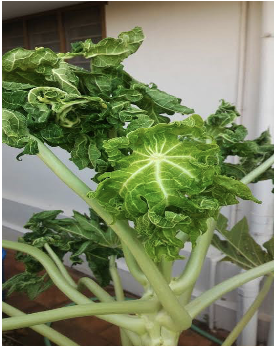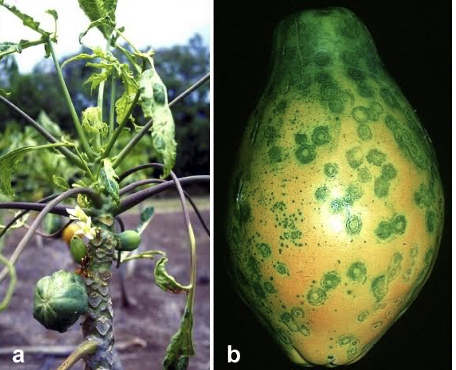🍐 Papya
Important points, varities, pests
- Botanical Name:
Carica papaya - Family:
Caricaceae - Origin:
Tropical America - Papaya was introduced in India in 16th century.
- It is a tropical fruit and more sensitive to frost.
- Carica candamarcensis — Mountain papaya.
- Highest productivity after Banana.
- India has 4th rank in papaya production in the world.
- Highest producing state in India -
Andhra Pradesh - Frost is the most limiting factor in papaya cultivation in north India.
- Papaya is thermosensitive crop.
- Papaya plants are very susceptible to water logging.
- Yellow pigment in papaya —
Caricaxanthin - Carpine obtained from papaya, is utilized as a diuretic and heart stimulent.
- Pepsin - Dried latex of Papaya contains this enzyme.
- Papain - Enzyme present in papaya for marinating meat and meat products.
- Papain contain 72.2% protein.
- Papaya is highly cross-pollinated plant.
- Papaya is commercially propagated by
seed. - Papaya is Polygamous plant i.e. Bearing some flowers with stamens only, some with pistils only, and some with both, on the same or different plants.
- Seed Rate for Gynodioecious (Gynodioecy is the evolutionary intermediate stage between hermaphroditism (exhibiting both female and male parts) and dioecy (having two distinct morphs: male and female variety) -
250-300 gm/ha. - Seed Rate for Dioecous (Plant in which male and female reproductive parts occur in different plants) -
400-500gm/ha. - 1 gram = 20 seeds of papaya.
- Seed are enclosed in gelatinous sarcotesta.
- Recommended spacing for
Pusa Nanhais 1.25 X 1.25 m2 (6000 plants/hac) - Damping off is most serious disease of papaya seedlings.
10% male plantis planted where dioecious varieties are cultivated.- Sunrise solo type of papaya produce no male plants.
- Irrigation by ring method.
Varieties
- Gynodioecous [DMCTSS]
- Pusa
Delicious - Pusa
Majesty: One of highest papain yielders Coorg honey dew: Selection from honey dew (Madhu Bindu) - HermaphroditeTaiwan – (Blood red flesh)Sunrise solo – (Pink flesh)Surya
- Pusa
- Dioecious Varieties
Pusa Nanha:Extremely dwarf, suitable for HDP (pot garden).- Pusa Giant: Suitable for tooty fruity and candies used in canning industry and have good wine resistance.
- Pusa Dwarf
- Hatras gold
- Betty
- Pant C-1
- CO-1: Dwarf
- CO-2
- CO-5: Cultivated mainly for papain extraction (Pupain yield 1500 – 1600 kg/ha).
- CO-6: Selection from Pusa Majesty
- Pink flesh sweet: TSS – 12-14° Brix
- Sunny bank
- Improved Peresons
- Hybrid
- CO-3: CO-2 x Sunrise Gold
- CO-4: CO-2 x Washinghton
- CO-7: Pusa delicious x Coorg honey dew
Disease
- Stem rot / Foot rot / damping off
- Pythium aphanidermatum
- It is most serious disease of papaya seedlings.
- Papaya Leaf curl

- Papaya leaf curl virus
- Spread by
whiteflyBemisia tabaci.
- Papaya ring spot

- Papaya ring spot virus
- Upper leaves of papaya is mottled.
- Transmitted by
aphid(Aphis gossipi).
- Management:
- Both white flies and aphids can be managed by spraying of any systemic insecticides i.e. Acephate @ 1.0 mllliter of water or Dimethoate 30 EC @ 1 ml/liter of water or
- Imidacloprid @ 0.5 ml/liter of water with Streptocyclin a 0.1 g /liter of water is also effective.
- Botanical Name:
Carica papaya - Family:
Caricaceae - Origin:
Tropical America - Papaya was introduced in India in 16th century.
- It is a tropical fruit and more sensitive to frost.
- Carica candamarcensis — Mountain papaya.
- Highest productivity after Banana.
- India has 4th rank in papaya production in the world.
- Highest producing state in India -
Andhra Pradesh - Frost is the most limiting factor in papaya cultivation in north India.
- Papaya is thermosensitive crop.
- Papaya plants are very susceptible to water logging.
- Yellow pigment in papaya —
Caricaxanthin - Carpine obtained from papaya, is utilized as a diuretic and heart stimulent.
- Pepsin - Dried latex of Papaya contains this enzyme.
- Papain - Enzyme present in papaya for marinating meat and meat products.
- Papain contain 72.2% protein.
- Papaya is …
Become Successful With AgriDots
Learn the essential skills for getting a seat in the Exam with
🦄 You are a pro member!
Only use this page if purchasing a gift or enterprise account
Plan
Rs
- Unlimited access to PRO courses
- Quizzes with hand-picked meme prizes
- Invite to private Discord chat
- Free Sticker emailed
Lifetime
Rs
1,499
once
- All PRO-tier benefits
- Single payment, lifetime access
- 4,200 bonus xp points
- Next Level
T-shirt shipped worldwide

Yo! You just found a 20% discount using 👉 EASTEREGG

High-quality fitted cotton shirt produced by Next Level Apparel